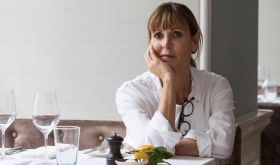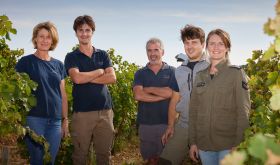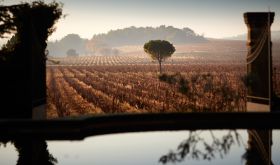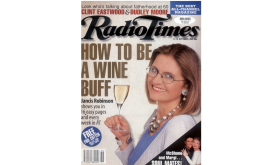Oxford romped home, again, in yesterday morning’s Oxford v Cambridge wine-tasting match organised by Champagne Pol Roger, notching up a total score of 768 points to Cambridge’s 632. The (all-male) Oxford team shown here with Hubert de Billy of Pol Roger was so confident that they didn’t even cheer when their win was announced.
Partly thanks to several longstanding members of the team and partly thanks to long-term coaching by academic (and Oxford Companion to Wine contributor) Hanneke Wilson, Oxford’s team has a long lineage. One of its recent members, Thomas Parker of Farr Vintners, has already passed both parts of the Master of Wine exam.
The Cambridge team, on the other hand, was made up largely of newcomers to the art of blind tasting. Three of its members have only a few months’ experience. Even the team’s captain, Jess Rose, and her husband and team coach, are relatively new to non-Australian wines. All of which makes their performance pretty impressive. Jess is on the extreme right of this picture of the two teams being briefed by James Simpson MW of Pol Roger before the competition.

Both teams take the competition incredibly seriously, with Cambridge holding four practice sessions a week in the lead-up to the event, and the Oxford team taking part in 25 blind tastings over the last six weeks.
The match, as usual, took place in the Oxford & Cambridge Club a few doors from wine-focused private members’ club 67 Pall Mall under the auspices of Champagne Pol Roger, with Hugh Johnson and me as hard-working judges. We always taste the wines blind ourselves so that we can see what other guesses might be allowed.
Six whites and then six reds are served blind. This year they all came from Justerini & Brooks just up the road on St James’s Street and, in my opinion, the whites were particularly tough – although the Cambridge team (just) scored better for whites than for reds.
The first white was a 2014 de Villaine Aligoté that, in my opinion, was over the hill. And anyway, Aligoté is hardly a distinctive grape to put nervous contestants at their ease. Help was at hand with a superb JJ Prüm, Wehlener Sonnenuhr Spätlese 2010 – the best wine in the entire tasting and the most recognisable. The other banker was the last, sixth, white, clearly a particularly well-made Chardonnay. I thought it too obviously technically clean and expressive to be burgundy (!) and that it could have come from virtually any cool non-European wine region. It turned out to be Felton Road Bannockburn Chardonnay 2016 Central Otago.
Wines three to five were less obvious. I don’t think anyone spotted the Correggio Arneis 2016 Roero that was an attractively crisp, well-balanced, rather floral white but was a bit less perfumed than some examples of Arneis. The Ott, Am Berg Grüner Veltliner 2016 Wagram was only 11.5% and therefore lighter than average. Wine number four was Vincent Pinard’s oaked Harmonie Sancerre 2014 – a Sauvignon Blanc but not as we know it. There was a little canned green vegetable quality to it but it was a tricky one to guess blind.
I thought the reds were more straightforward. They kicked off with a very nice, very obvious Pinot Noir, Peay Vineyards, Ama Estate 2014 Sonoma Coast. It was not too technical, so hovered somewhere mid Atlantic – as did the guesses. The next wine was another banker, obviously a northern Rhône Syrah. I wondered whether it was one of those glorious 2014 Crozes-Hermitages but in fact it was a very impressive Cornas, Les Billes Noires 2012 from Dom du Coulet. (It was funny how enthusiastic we old MWs, James Simpson of Pol and me, were about this wine, whereas the younger members of the team accused it of brett.) Next was a very dense, oaky, youthful Aalto 2015 Ribera del Duero. Hugh spotted the Tempranillo in a trice; I found it buried under the oak. Then came a particularly plump, fruity Rosso di Montalcino 2013 from Le Ragnaie. I don’t think that many tasters picked it as a Sangiovese. The Beaujolais was as atypical as the Sauvignon Blanc had been: a particularly ambitious, full-on, traditionally vinified Laurent Martray, Combiaty Vieilles Vignes 2015 Brouilly, while the final wine was even more of an oddball, a Heitz, Ink Grande Vineyard Zinfandel 2012 Napa Valley.
Of all these, the Prüm, Felton Road, Peay and Coulet wines were my standouts for quality and, I now realise, guessability.
All in all, the tasters did brilliantly – well up to the standard of many wine professionals. And I was told at the lunch afterwards that several team members, with their superior intellects, are thinking seriously about joining the wine trade (following the path trod by our old contributor Alex Hunt MW whom I first met at a varsity tasting match).
Admittedly, mirroring the make-up of the teams in the varsity Boat Race, there were very few undergraduates – just one per team, I think. And there were very few Brits in the teams – and a significant proportion of Asians. The taster who notched up the highest individual score (160 points, almost double the lowest score) was American Neil Alacha (far right of the team picture), currently studying international relations at Oxford prior to returning to the US to study law. All of this merely mirrors the evolution of the wine-drinking world.
One interesting coda: psychologist Janice/Qian Wang (married to Oxford’s team captain Domen Presern; their engagement party was a blind tasting) works with Charles Spence and has already published very interesting findings on how we perceive wine and music. She is analysing all the results from the 25 preparatory blind tastings conducted by the Oxford team to see what effect training blind tasters has. At least I think that’s what the aim was. The results will be presented at Cornell in New York state and will be published by the American Association of Wine Economists.













